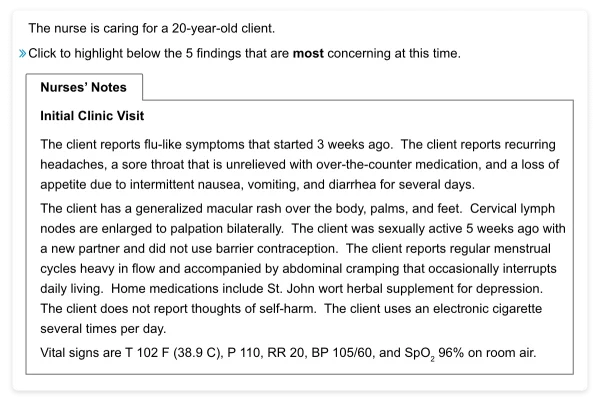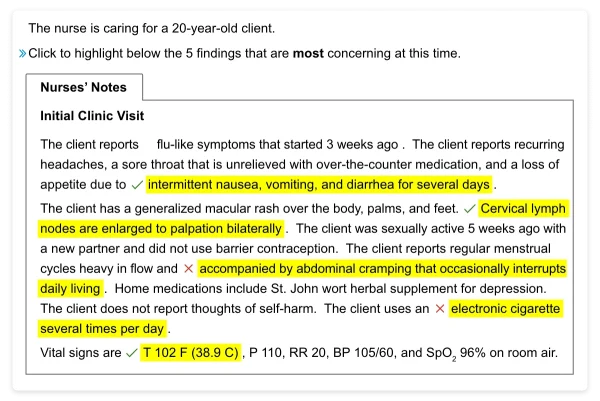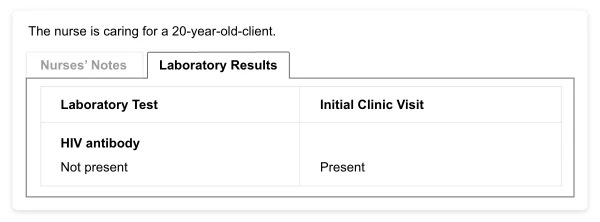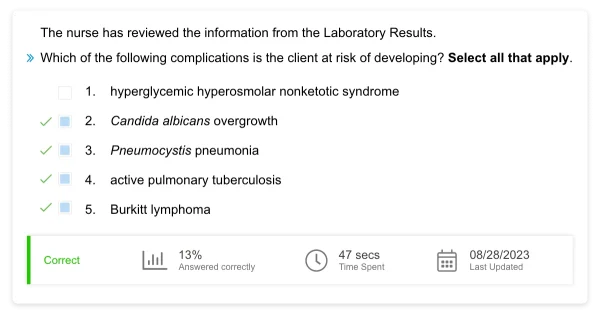If you're preparing for the Next Generation NCLEX® (NGN), chances are you've encountered the new case study format in your practice questions. These questions can feel intimidating at first — but with a little strategy, they become one of the most rewarding parts of the exam.
In this post, we’ll break down what NGN case studies are, how they’re structured and scored, and how to approach them like a pro.
Already been through a few NGN case studies? Feel free to skip ahead to the tips section — we’ll meet you there!
What Are NGN Case Studies?
NGN case studies are designed to assess your clinical judgment — the heart of safe, effective nursing care. Each case study presents a detailed clinical scenario across 6 questions, walking you through the full arc of a patient situation from assessment to evaluation.
What’s different about NGN case studies is how intentionally they mirror real-world decision-making. You’re not just recalling facts — you’re being tested on how you recognize cues, analyze information, make decisions, take action, and evaluate outcomes.
This structure is grounded in the Clinical Judgment Measurement Model (CJMM), developed by the NCSBN. It mimics the nursing process but with an added focus on decision-making under pressure. Here's how the model flows:
| 6 Steps of Clinical Judgment (Based on NCJMM)1 | |||
|---|---|---|---|
| Step | Description | ||
| 1. Recognize Cues | Identify relevant and important information from different sources (e.g., medical history, vital signs). | ||
| 2. Analyze Cues | Organize and connect the recognized cues to the client’s clinical presentation. | ||
| 3. Prioritize Hypotheses | Evaluate and prioritize hypotheses based on urgency, likelihood, risk, difficulty, and time constraints. | ||
| 4. Generate Solutions | Identify expected outcomes and use hypotheses to define a set of interventions for those outcomes. | ||
| 5. Take Action | Implement the solution(s) that address the highest priority. | ||
| 6. Evaluate Outcomes | Compare observed outcomes to expected outcomes. | ||
Each question in the case study aligns with 1 of these 6 steps. The goal? To measure how you think like a nurse in real time.
How NGN Case Studies Unfold
Each case study is built around a single client scenario. The structure stays consistent:
Clinical Scenario
This is your main story, typically delivered across several tabs like Nurse’s Notes, History & Physical, Vitals, Lab Results, or Diagnostics. These give you the evolving context for your decision-making.


With NGN case studies, sometimes you get all the client info up front — but often, just like real life, new details pop up as the scenario unfolds. You’ll want to read those updates carefully and answer each question as it comes since you won’t be able to go back on exam day.


NGN Question Types
NGN case studies pull from a mix of traditional and new item types. Some questions might look familiar, while others use new formats that focus on clinical reasoning. Here’s a quick reference:
| NGN Question Types | |||
|---|---|---|---|
| Question Type | What It Looks Like | ||
| Multiple Response (SATA) | Select all that apply; can be traditional or newer matrix style | ||
| Drop-Down Cloze | Fill-in-the-blank with drop-down menus for decision pathways | ||
| Matrix/Grid | Match findings to conditions or actions to outcomes | ||
| Highlight | Click on words or phrases in a passage to identify relevant data | ||
| Ranking | Order actions or responses based on priority | ||
| Single Best Answer | 1 correct response — often used for evaluating outcomes | ||
How NGN Case Studies Are Scored
Scoring for NGN items can feel tricky, but here's the gist:2
- Partial Credit: Most items give credit for each correct selection.
- No Negative Scoring: You won’t lose points unless you’re told selecting a wrong answer will be deducted from your score (as in some matrix questions).
- Zero-One Scoring: Some questions require you to get all parts right to earn credit.
- Scoring Rules Are Shown: If partial or all-or-nothing scoring applies, UWorld’s NGN questions tell you with a scoring rule tooltip.
This means you can still earn points even if you don’t get every part of the question perfect — especially if you’re thoughtful with your answers.
Tips for Solving NGN Case Studies
Tackling an NGN case study is about thinking like a nurse. Here’s how to work through them with confidence:
1. Anchor Yourself in the CJMM
Each question is testing a specific skill. Before you even look at the answer choices, ask yourself:
“What step of the clinical judgment model is this testing?”
Are you recognizing cues? Prioritizing hypotheses? That mental framework will guide your thinking.
2. Read the Clinical Scenario Carefully
Start with the “Nurse’s Notes” — they often tell you where you are (e.g., ED, med-surg) and why the patient is here. Then explore “History & Physical,” “Vitals,” and “Labs” to complete your mental picture.
For example: If the patient presents with chest pain and anxiety, don’t stop at the symptoms — dig into their vital signs, ECG, and mental status. Is this a panic attack? A heart attack? Both?
3. Follow the Clues — Don’t Jump to Conclusions
Look at patterns. For example:
- Tachycardia and diaphoresis could indicate MI, hyperthyroidism, or anxiety.
- Flat affect and fidgeting could point to depression or panic disorder.
Click carefully. Only select what you can back up from the scenario.
4. Use the Exhibits Wisely
If the question says “reviewed labs and diagnostics,” go check those tabs. Even if you think you know the answer, make sure it’s grounded in what the question provides. This is especially true for follow-up intervals, like when vitals or anxiety scores are updated.
5. Decode the Scoring Hints
Pay attention to phrases like:
- “Select all that apply”: Partial credit likely
- “One answer per row”: Matrix multiple choice, no penalties
- “Selecting incorrect options will reduce score”: Be cautious!
6. Think Like a Nurse Educator
Ask yourself: What would I teach this patient? This helps especially with medication and discharge questions.
For example:
- Don’t drive after alprazolam.
- Contact your provider if experiencing suicidal thoughts on an SSRI.
- Don’t stop benzodiazepines abruptly due to withdrawal risks.
7. Use Prioritization Language Cues
Look for bolded words like “immediate,” “highest priority,” or “most concerning.” These indicate a prioritizing hypotheses question — and you should apply ABCs, Maslow’s, or other frameworks accordingly.
8. Learn from Feedback
Use NGN practice questions with explanations that break down why each choice was right or wrong. Even if you get it right — read the rationale. This is where deep learning happens.
9. Practice with Exam-Like Questions
If you want the real exam to feel like second nature, start practicing like it’s the real thing. Try a few of our NGN-style sample questions — they’re designed to mirror the actual exam and help you build confidence, one scenario at a time.
Frequently Asked Questions (FAQs)
How many case study questions are on the NGN?
Can I go back to previous questions in a case study?
Do NGN questions use only new item types?
How are NGN case studies scored?
What’s the best way to study for NGN case studies?
References
- National Council of State Boards of Nursing. (2023). 2023 NCLEX-RN Test Plan: English. https://www.ncsbn.org/exams/testplans.htm
- National Council of State Boards of Nursing. (2021). Scoring Methods for the Next Generation NCLEX.https://www.ncsbn.org/public-files/presentations/2021_MYM_pdickison_NGN.pdf








